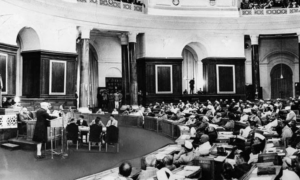The idea of a Constituent Assembly to frame a constitution for India was first proposed by Manabendra Nath Roy, popularly known as M.N. Roy, a radical leader and thinker, in 1934. Later in 1935, it was endorsed by the Indian National Congress, the main political party fighting for independence.
The Constituent Assembly of India was formed in 1946 on the basis of the Cabinet Mission Plan. It had 389 members, out of which 292 were from British provinces, 93 from princely states, and 4 from Chief Commissioner’s provinces.

Constituent Assembly | Photo Credit: Live Law
The Constituent Assembly met for the first time on 9 December 1946 in New Delhi. Dr. Sachidananda Sinha was elected as its interim president. The Muslim League initially agreed to participate in the Constituent Assembly but later boycotted it due to its dissatisfaction with the interim government formed by the Congress.
Dr. Rajendra Prasad later became its permanent president and Dr. B.R. Ambedkar became its Chief Drafter. The Constituent Assembly had eight major committees and several minor committees to deal with various aspects of the Constitution. The most important committee was the Drafting Committee, chaired by Dr. Ambedkar, which prepared the draft constitution based on the reports of other committees.
The Constituent Assembly faced many challenges and difficulties during its work. It had to cope with the partition of India into two dominions: India and Pakistan, which resulted in violence and displacement of millions of people. It also had to deal with the integration of Princely states into the Indian union, which involved persuasion and coercion. It also had to balance the conflicting demands and interests of various groups and regions, such as linguistic minorities, religious communities, women, backward classes, etc.
The constitution came into force on January 26, 1950, which was declared as the Republic Day of India. It marked the beginning of a new era for India. It established India as a sovereign, secular, and democratic republic with a parliamentary system of government. It also guaranteed various fundamental rights and duties to its citizens and laid down the principles and procedures for the functioning of the government at the central and state levels.
Continue to the next section: Committees under Constitutional Assembly
